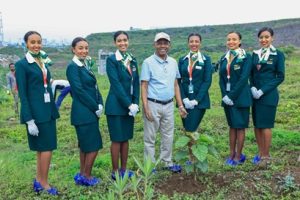BY EPHREM ANDARGACHEW
Ethiopia is rich’s in biodiversity and endowed with diverse crops species. Conserving the biodiversity in the nation is significant to obtain resources for sustainable development. Every nation including Ethiopia conserves its biodiversity with the main objectives of sustainable utilization of species and ecosystem and maintaining life-supporting systems and essential ecological processes.
During his interview with The Ethiopian Herald, Wubeshet Teshome, Ethiopian Biodiversity Institute Crop and Horticulture Director has elaborated on the biodiversity conservation of the nation with particular references to the multiple benefits indigenous crops and horticulture species. Have a nice read:
Would you please update us on the current biodiversity conservation activities of the country?
In Ethiopia, the conservation of crops and horticulture dates back to more than 40 years. since research, conservation and sustainable utilization are our primary activities, the institute currently, centres on various methods to collect crops and horticulture samples for conservation. Besides, the work of conservation has been held using 3E criteria namely endangered, endemic, and economically important. Further, the conservation work has been done in two ways. In-situ and ex-situ conservation methods.
In-situ conservation is the conservation of indigenous species by maintaining them in the natural ecosystem in which they occur. This method is important to conserve indigenous species in the adopted agroecology zone. So far, the institution has conserved 148 crops types and plans to reach 169 crops types in the next ten years’ time. Ex-situ conservation is another way of conserving indigenous species. It is used to collect orthodox seeds whose moisture content exits a long time, and we put them in the cold room.
These are important to conserve the country’s endemic, endangered, and economically important seeds for a long time. Apart from in-situ and Ex-situ conservation, there is a method called on farm-conservation. This is important to protect the indigenous species seed from climate change, newly coming crops disease and so on. It also increases the resilience of seeds to tackle disease and drought. In short, with the ups and downs and all difficulties, the institution has been working to conserve the nation’s indigenous crops and horticulture species.
It is true that the institution collects and conserves indigenous crop and horticulture species before they perish due to various factors. As a nation, what are the factors that are threatening the species in Ethiopia?
Due to several factors, the indigenous species of crops of the country have been facing various problems such as drought, construction of infrastructure, modernization, new ways of lifestyle, and so on. It is general knowledge that Ethiopia has diverse biodiversity and endemic crops species. Some crops are found in an easy way while others are tough to reach.
Hence, the collection of samples has been conducted either on foot or along main roads following the path using vehicles. Because we have no helicopters to reach out to inaccessible indigenous crop species which is a big challenge to the sector. In order to study each and every species, facilities such as helicopters, running materials, vehicles, and so on are necessary.
The absence of tissue culture or DNA conservation is another challenge to our biodiversity conservation since Ethiopia does not conserve indigenous species in the form of DNA. Conserving only seeds is not good since the conservation system is exposed to various problems. It can be lost or damaged at any time by sudden accidents.
For instance, before things were changed in Syria, Ethiopia was used to conserving indigenous species seeds there. When the civil war breakout, Ethiopia’s conserved species have destroyed in Syria. So, conserving species only through seeds is not reliable, it is also important conserving via tissue culture or DNA.
Lack of awareness or proper understanding of the nature of biodiversity in Ethiopia is another challenge for the sector. Ethiopians must understand the biodiversity of the country and use it in a proper manner. Other countries or foreigners by taking Ethiopian indigenous species and put their fingerprints to take patent rights for them. They have been benefitting a lot while we neglected what we have and focused on only select seeds. Therefore, it is important to comprehend and use indigenous species properly.
Next to farmers or communities, how do you help the researchers, institutions, or other persons who are conducting researchers?
In order to support the researchers, we have a policy of characterization. Characterization is a method that the institution researchers have been conduction research regarding the species in various ways. For instance, if a researcher wants to conduct research, he/she has to collect samples across the nation which is impossible and time taking. So, what we do is the institution do morphological characters’ research and conserve them. Besides, the institution studies molecular study by extracting the DNA.
The study also includes a static value, nutrition value, the crops’ drought resilience value, and so on. Following the research, we conduct an agro-climatic zone evaluation of the species. These would help the researchers to have initial inputs. Hence, these processes and activities pave the way for another researcher to do more fruitful researches. So far, the institution has distributed 250 thousand samples to universities and research centres. In this way, the institution is contributing its part to the research development of the sector.
As you said the work of conservation has been held using 3E criteria namely endangered, endemic, and economically important. So, do you study only crops or horticulture that have economic values?
In fact, it is not important to conserve economically insignificant crop seeds. Nevertheless, there are crops or horticulture which need conservation due to esthetic value, cultural value, ecological use, and so on. Because what matters is the value that the society or the farmers give is important. Therefore, in order to conserve crops, economic value or commercial value only is not important. Ethiopia is endowed with various crop species with diverse values. So, only economic values are not a criterion to conservation the endemic specious of the nation.
Are Ethiopian crops or horticulture seeds climate change resilient compared with immigrant species?
Ethiopia has several drought-resistant species or crops. Besides, its indigenous crops or horticulture are better in mitigating climate change than select seeds. Because it adopts the weather condition of the country. This has been also proved through participatory researches across the nation. Under the controlled supervision of the institution, the study allows both men and women farmers to participate in it. Based on, therefore, production, mitigation of climate change, the resilience of diseases, and so on, the indigenous crops and horticulture are better than immigrant’s species however, the amount of production compared with select seeds.
Finally, compared with other countries’ experiences, how do you see our country’s biodiversity conservation?
There are no such things called indigenous species in developed countries since they have identically select seeds. Because they almost lost their indigenous species. This means select seeds are the same, and it’s difficult to produce the best seeds from the select one, select seeds imply the best seeds. Accordingly, the indigenous specious are important to get select seeds since they have diverse and variety of species.
Developed countries need to have indigenous seeds or species to improve production because they almost lost their species. Whereas compare to the rest of the world, Ethiopia has 82346 sample species and one-third of Africa’s species are found in Ethiopia. Therefore, Ethiopia has a better biodiversity experience in the world. Like I mentioned previously, the world experiences show that conserving seeds only is venerable to different problems. So, it is important to move faster to conserve seeds through DNA.
I thank you very much for sharing your time with us,
I thank you
The Ethiopian Herald September 25/2021




